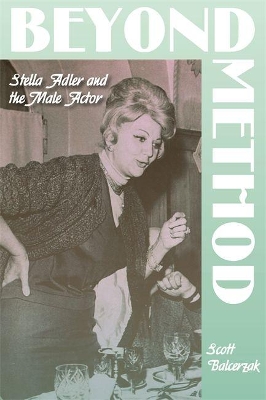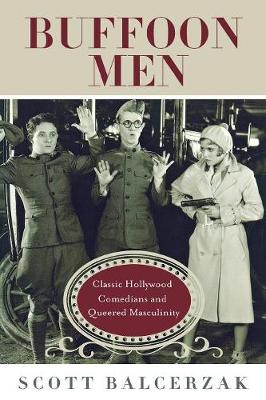Contemporary Approaches to Film and Media
2 total works
Stella Adler (1901-92) trained many well-known American actors yet throughout much of her career, her influence was overshadowed by Lee Strasberg, director of the Actors Studio. In Beyond Method: Stella Adler and the Male Actor, Scott Balcerzak focuses on Adler's teachings and how she challenged Strasberg's psychological focus on the actor's ""self"" by promoting an empathetic and socially engaged approach to performance. Employing archived studio transcripts and recordings, Balcerzak examines Adler's lessons in technique, characterization, and script analysis as they reflect the background of the teacher-illustrating her time studying with Constantin Stanislavski, her Yiddish Theatre upbringing, and her encyclopedic knowledge of drama. Through this lens, Beyond Method resituates the performances of some of her famous male students through an expansive understanding of the discourses of acting.
The book begins by providing an overview of the gender and racial classifications associated with the male ""Method"" actor and discussing white maleness in the mid-twentieth century. The first chapter explores the popular press's promotion of ""Method"" stars during the 1950s as an extension of Strasberg's rise in celebrity. At the same time, Adler's methodology was defining actor performance as a form of social engagement-rather than just personal expression-welcoming an analysis of onscreen masculinity as culturally-fluid. The chapters that follow serve as case studies of some of Adler's most famous students in notable roles-Marlon Brando in A Streetcar Named Desire (1951) and The Missouri Breaks (1976), Robert De Niro in Taxi Driver (1976), Henry Winkler in Happy Days (1974-84), and Mark Ruffalo in The Avengers: Age of Ultron (2015). Balcerzak concludes that the presence of Adler altered the trajectory of onscreen maleness through a promotion of a relatively complex view of gender identity not found in other classrooms.
Beyond Method considers Stella Adler as not only an effective teacher of acting but also an engaging and original thinker, providing us a new way to consider performances of maleness on the screen. Film and theater scholars, as well as those interested in gender studies, are sure to benefit from this thorough study.
The book begins by providing an overview of the gender and racial classifications associated with the male ""Method"" actor and discussing white maleness in the mid-twentieth century. The first chapter explores the popular press's promotion of ""Method"" stars during the 1950s as an extension of Strasberg's rise in celebrity. At the same time, Adler's methodology was defining actor performance as a form of social engagement-rather than just personal expression-welcoming an analysis of onscreen masculinity as culturally-fluid. The chapters that follow serve as case studies of some of Adler's most famous students in notable roles-Marlon Brando in A Streetcar Named Desire (1951) and The Missouri Breaks (1976), Robert De Niro in Taxi Driver (1976), Henry Winkler in Happy Days (1974-84), and Mark Ruffalo in The Avengers: Age of Ultron (2015). Balcerzak concludes that the presence of Adler altered the trajectory of onscreen maleness through a promotion of a relatively complex view of gender identity not found in other classrooms.
Beyond Method considers Stella Adler as not only an effective teacher of acting but also an engaging and original thinker, providing us a new way to consider performances of maleness on the screen. Film and theater scholars, as well as those interested in gender studies, are sure to benefit from this thorough study.
Film scholars and fans have used distinctive terms to describe the Classic Hollywood comedian: He is a ""trickster,"" a ""rebel,"" or a ""buffoon."" Yet the performer is almost always described as a ""he."" In Buffoon Men: Classic Hollywood Comedians and Queered Masculinity, Scott Balcerzak reads the performances of notable comedians such as W. C. Fields, Eddie Cantor, Jack Benny, Stan Laurel and Oliver Hardy, Bert Wheeler and Robert Woolsey, and Bud Abbott and Lou Costello through humor and queer theory to expose a problematic history of maleness in their personas. He argues that contrary to popular notions of Classic Hollywood history, these male comedians rearranged or, at times, rejected heteronormative protocols.
Balcerzak begins by defining the particular buffoonish masculinity portrayed by early film comedians, a gender and genre construct influenced by the cultural anxieties of the 1930s and '40s. In chapter 1, he considers the onscreen pairing of W. C. Fields and Mae West to identify a queered sexuality and drag persona in Fields's performance, while in chapter 2 he examines the two major constructions of Fields's film persona-the confidence man and the husband-to show Fields to be a conflicted and subversive figure. In chapter 3, Balcerzak considers the assimilation and influence of Eddie Cantor as a Jewish celebrity, while he turns to the cross-media influence of Jack Benny's radio persona in chapter 4. In Chapters 5 and 6, he moves beyond the individual performer to examine the complex masculine brotherhood of comedy duos Laurel and Hardy, Abbott and Costello, and Bert Wheeler and Robert Woolsey.
Buffoon Men shows that the complicated history of the male comedian during the early sound era has much to tell us about multimedia comedic stars today. Fans and scholars of film history, gender studies, and broadcast studies will appreciate Balcerzak's thorough exploration of the era's fascinating gender constructs.
Balcerzak begins by defining the particular buffoonish masculinity portrayed by early film comedians, a gender and genre construct influenced by the cultural anxieties of the 1930s and '40s. In chapter 1, he considers the onscreen pairing of W. C. Fields and Mae West to identify a queered sexuality and drag persona in Fields's performance, while in chapter 2 he examines the two major constructions of Fields's film persona-the confidence man and the husband-to show Fields to be a conflicted and subversive figure. In chapter 3, Balcerzak considers the assimilation and influence of Eddie Cantor as a Jewish celebrity, while he turns to the cross-media influence of Jack Benny's radio persona in chapter 4. In Chapters 5 and 6, he moves beyond the individual performer to examine the complex masculine brotherhood of comedy duos Laurel and Hardy, Abbott and Costello, and Bert Wheeler and Robert Woolsey.
Buffoon Men shows that the complicated history of the male comedian during the early sound era has much to tell us about multimedia comedic stars today. Fans and scholars of film history, gender studies, and broadcast studies will appreciate Balcerzak's thorough exploration of the era's fascinating gender constructs.

